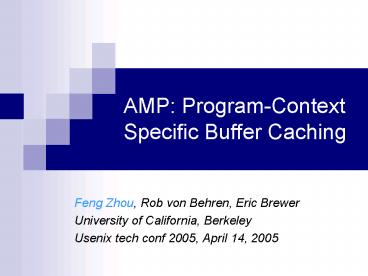AMP: ProgramContext Specific Buffer Caching - PowerPoint PPT Presentation
1 / 16
Title:
AMP: ProgramContext Specific Buffer Caching
Description:
Usenix tech conf 2005, April 14, 2005. 2. Buffer caching beyond LRU ... Detection: UBM (OSDI'00), DEAR (Usenix'99), PCC (OSDI'04) ... – PowerPoint PPT presentation
Number of Views:28
Avg rating:3.0/5.0
Title: AMP: ProgramContext Specific Buffer Caching
1
AMP Program-Context Specific Buffer Caching
- Feng Zhou, Rob von Behren, Eric Brewer
- University of California, Berkeley
- Usenix tech conf 2005, April 14, 2005
2
Buffer caching beyond LRU
- LRU good for workload with temporal locality, but
very bad for loops and scans - Large (gtcache size) one-time scan evicts all
blocks - Large (gtcache size) loops get zero hits
- Renewed interests in buffer caching
- Adaptation ARC (FAST03), CAR (FAST04)
- Detection UBM (OSDI00), DEAR (Usenix99), PCC
(OSDI04) - basic idea detect loops and scans and apply MRU
or variant
3
Adaptive Multi-Policy (AMP) caching
- Robust algorithm for detecting looping patterns
- more robust against local reorders or small
spurious loops - Randomized scheme for managing many cache
partitions - much cheaper than previous precise methods
- PC-specific caching that classifies disk accesses
by program contexts - independent from PCC by Gniady et al (OSDI04)
4
PC-specific Buffer Caching
- Program context the current PC all return
addresses on the call stack
Ideal policies 1 MRU 2 LFU
3 LRU
5
Loop detection scheme
- Intuition measure the average recency of the
blocks accessed - For the i-th access
- Li list of all previously accessed blocks,
ordered from the oldest to the most recent by
their last access time. - Li length of Li
- pi position in Li of the block accessed (0 to
Li-1) - Define the recency of the access as,
6
Loop detection scheme cont.
- Average recency R of the whole sequence is the
average of all defined Ri (0ltRlt1) - Detection result
- loop, if R lt Tloop (e.g. 0.4)
- temporally clustered, if R gt Ttc (e.g. 0.6)
- others, o.w. (near 0.5)
7
Loop detection example 1
- Block sequence 1 2 3 1 2 3
- R 0, detected pattern is loop
8
Loop detection example 2
- Block sequence 1 2 3 4 4 3 4 5 6 5 6, R 0.79
9
Randomized Cache Partition Management
- Need to decide cache sizes devoted to each PC
- Marginal gain (MG) the expected number of extra
hits over unit time if one extra block is
allocate - Local optimum when every partition has the same
MG - Concrete scheme
- Expand the LRU partition by one if ghost buffer
hit - Expand an MRU partition by one every
loop_size/ghost_buffer_size accesses to the
partition - Compared to previous schemes
- No need to find partition smallest MG (O(logN))
10
Detection of synthesized sequences
tctemporally clustered Colored detection
results are wrongClassifying tc as other is
deemed correct.
11
Simulation dbt3 (tpc-h)
12
Simulation scan
13
Implementation
- Kernel patch for Linux 2.6
- Shortens time to index Linux source code using
glimpseindex by up to 13 (read traffic down 43) - Shortens time to complete DBT3 (tpc-h) DB
workload by 9.6 (read traffic down 24) - Linux implementation and simulatorhttp//www.cs.
berkeley.edu/zf/amp
14
(No Transcript)
15
DBT3 on AMP implementation
- Overall execution time reduced by 9.6 (1091 secs
?986 secs) - Disk reads reduced by 24.8 (15.4GB ? 11.6GB),
writes 6.5
16
Correctness of partition size adaptation
- During time period t, number of expansion of ARC
is -
(B1B2ghost_buffer_size) - The number of expansions of an MRU partition i is
- They are both proportional to their respective MG
with the same constant































